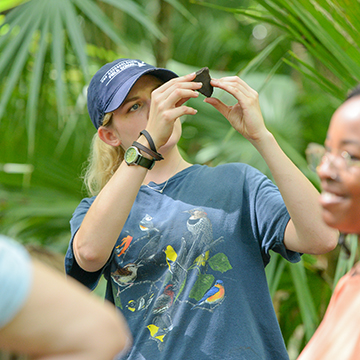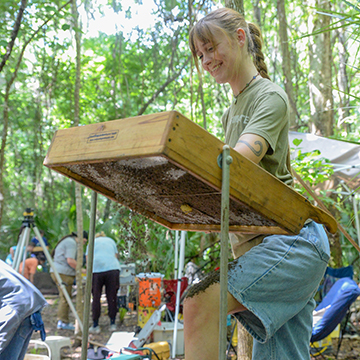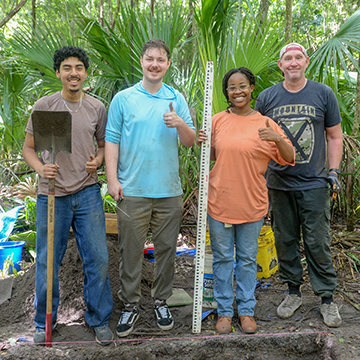UNF archaeology and NPS digging deeper into curious shell formations at Timucuan Preserve
 University of North Florida archaeology students are spending the summer digging deep in shell and dirt at the Cedar Point North site within the Timucuan Ecological and Historic Preserve.
University of North Florida archaeology students are spending the summer digging deep in shell and dirt at the Cedar Point North site within the Timucuan Ecological and Historic Preserve.
This ongoing project represents a large-scale collaboration between UNF and the National Park Service (NPS) that began in spring 2023. The results of their research and tests, along with previous archaeological work at the site, will contribute greatly to our understanding of the Indigenous people, history and environment of northeastern Florida approximately 800 to 1,000 years ago.
The 16-member student team is led by Dr. Keith Ashley, a UNF archaeology professor who has worked to uncover local Indigenous history for over 20 years, and UNF anthropology graduate Victoria Hayes, who is interning for the NPS and researching Cedar Point North for her master’s thesis.
The Cedar Point North site consists of large mounds and ridges of densely packed shell refuse. The team is currently excavating a trench through one of the shell ridges and testing areas adjacent to the shell formations. They are also using a total station to create detailed topographic maps of the shell configurations.
“We want to understand how these unique shell formations were constructed and if their design is evidence of intentional human-made architecture or merely random piles of garbage,” said Ashley.
Along these lines, Hayes is exploring the possibility that the shell ridges are aligned in accordance with certain astronomical phenomena, such as solstices or equinoxes.
“Lunar cycles may have been important to Indigenous groups at Cedar Point North because of the moon’s effect on tides and thus oyster availability,” said Haynes. “But we also must be open to the possibility that these shell configurations have no relation to celestial events.”
The massive piles of shells, mainly oysters, and other cultural materials were deposited about 1,000 years ago. Testing of these shell formations has uncovered artifacts, mostly consisting of Indigenous pottery that seems to have primarily been used for heavy duty cooking. Most pottery fragments exhibit check-stamped and plain surface decorations. In addition to shell and pottery, the bones of fish, deer, turtles and other animals have been recovered by UNF students thus far.
Background site research
 In Spring 2023, Ashley and Hayes began background research on the Cedar Point North site. First recorded in the 1950s by John Goggin, Cedar Point North contains an impressive series of shell mounds and ridges of varying shapes and sizes distributed over a broad area. Other than surface collections made by Goggin, the only other archaeological work conducted at the site was limited testing performed in the 1990s by Mike Russo, who was contracted by NPS to survey select portions of the Timucuan Preserve. Russo’s survey recovered pottery, but he only sampled one of the shell mounds.
In Spring 2023, Ashley and Hayes began background research on the Cedar Point North site. First recorded in the 1950s by John Goggin, Cedar Point North contains an impressive series of shell mounds and ridges of varying shapes and sizes distributed over a broad area. Other than surface collections made by Goggin, the only other archaeological work conducted at the site was limited testing performed in the 1990s by Mike Russo, who was contracted by NPS to survey select portions of the Timucuan Preserve. Russo’s survey recovered pottery, but he only sampled one of the shell mounds.
After the UNF team consulted LiDAR imagery and conducted a quick reconnaissance survey, they saw many densely packed shell mounds, ridges and arc formations beneath a dense tree canopy on the site. One of the ridges resembles a snake from the air and stretches along the marsh edge for nearly 185 yards.
Following a field visit in spring 2023, the UNF team decided to undertake a brief project at Cedar Point North in July 2023. Hayes applied for and was awarded a Timucuan Preserve student research grant to map, sample and date a couple of the shell deposits. After securing a federal ARPA permit for archeological investigations from the NPS, Ashley, Hayes and four UNF field school students spent a week mapping and testing the two southernmost shell formations present at the site.
 The UNF team spent six weeks on the site testing two more shell formations in May and June 2024. Hayes spent the second half of the summer analyzing the field school artifacts. Ashley and Hayes returned to Cedar Point North for a week of additional shovel testing in December 2024, with the help of current and former UNF students. The 2024 shovel testing results assisted the team in locating productive areas to sample near one of the shell formations during the 2025 field school.
The UNF team spent six weeks on the site testing two more shell formations in May and June 2024. Hayes spent the second half of the summer analyzing the field school artifacts. Ashley and Hayes returned to Cedar Point North for a week of additional shovel testing in December 2024, with the help of current and former UNF students. The 2024 shovel testing results assisted the team in locating productive areas to sample near one of the shell formations during the 2025 field school.
“It has been an incredible experience to work on this project from the beginning,” said Hayes. “I participated in all aspects of archaeological work: applying for funding, designing and conducting research, field lab work and reporting the results. This has solidified my true passion and love for archaeology.”
